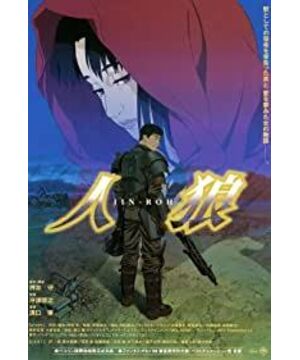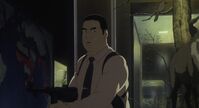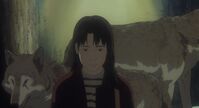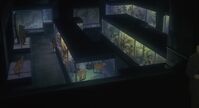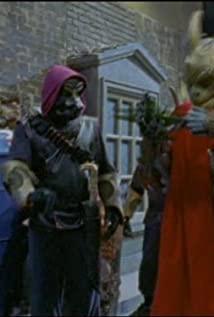Although there are many real political and ideological signs in the film, in general, the specific reference to history is weakened, and the lower level is highlighted: under the harsh social deprivation , the group animality and choice of man, which can undoubtedly be reproduced in various historical situations. In this film, the male and female protagonists gave up thinking, but did not give up social existence, so as to show this aspect, and show that it is not an artificial special case in the film, an experiment in extreme situations, but a situation of violence in history the norm.
When the civil war for Leviathan heats up and everyone has the fear of death, those with the will to survive will choose to join the organization that is most capable of monopolizing violence and providing order. He did it not first of all because of any thought, concept, or vision, but simply out of a cool instinct for survival.
But these organizations operate with laws that go beyond personal perception. Just as a corporate legal person conforms to the calculation of overall profits, an organization that obtains survival and power by violence conforms to the overall calculation of killing and being killed, obeying and being obeyed. Hence the transition from the everyday self to a group member whose goal is to violently seize power requires a process. If the ego is still somewhat passive, it needs to undergo a highly traumatic transformation ritual. In this film, the death of the female character becomes a ritual sacrifice and is placed in a fairy tale (mythical) story script.
From a conventional point of view, joining an organization requires a uniform uniform, covering up individuality, integrating into the collective identity, and "uniting as one"; rigorous training is required to generate conditioned reflexes and learn the skills to become a true collective. Just like the rebuke of the instructor after the assault training in the film: Individuals have obvious weaknesses, so they need to learn to cover each other and become a real whole to gain strength, just like the advantage of wolves is group hunting. They are constantly practicing, and they train each other in confrontation with the enemy, weeding out members of both groups who are not suitable for this game; it is also necessary to eliminate sympathy for outsiders, debate about good and evil, and emotional private judgment. Naive and impractical, become someone made of special materials. The betrayal of the protagonist's friend is an example.
This film attempts to show: 1. This process does not need to use incitement and conceptual "brainwashing", but only mobilizes people's instinct to use violence and rely on groups to survive. Under certain circumstances, choosing not to be a perpetrator means being a weakling to be slaughtered; 2 For some passive people, this process requires a ritual to transform themselves. (It is not necessary for active people like the protagonist's friend.) Once a decisive choice is made, it is difficult to turn back. If you kill one for the collective organization, you will continue to kill to maintain the continuity of the new self.
(2) The fairy tale
in the story of "Little Red Riding Hood" in the film:
1. The relationship between wolves and people seems to be a brutal beast and an innocent person, but it is actually a life-and-death war. Because the hunter is outside the house, people are not naive. Little Red Riding Hood is an accomplice of hunters from the perspective of group membership, just as the heroine is the bait of the enemy.
2 On the surface, the male protagonist is the friend, lover, and protector of the weak (the female protagonist). In fact, he eventually becomes a wolf disguised as Little Red Riding Hood's mother. He seems to be a protective and authoritative character, but in fact he wants to eat it. people who trust him.
3 But both of them were in fact instruments that were voluntarily dispatched by the organization in order to survive. They repress private emotions, play assigned roles, and foresee the emptiness of the future. From this point of view, the two people's living conditions are similar, so they have mutual attraction and sympathy. The difference is that the female protagonist lost her will to survive and sank into the illusion, while the male protagonist found a group to belong to voluntarily.
4 In the story, Little Red Riding Hood was hungry, and the wolf gave her mother's flesh and blood to eat, just as the wolf disguised himself as a nurturer and a sovereign, allowing the child of the weak to obtain false hope and temporary satisfaction, and let him unwittingly divide the food. same or attacking each other.
5 The heroine recited a fairy tale before her death and regarded the hero as the "mother" played by the wolf, which is indeed true: only the strong can protect the weak, but the situation of the weak who give up resistance is actually being slaughtered by others.
(3) Ceremony in a dream
In the middle of the whole film is the passage of the male protagonist going to "throwing himself into the net" to rescue the female protagonist. This is a fragment of the myth of redemption, which is then turned into a ritual of killing. But the ceremony was first predicted in a nightmare. One-third and two-thirds of the entire film is set in a rooftop amusement park. This little off-the-ground amusement park symbolizes a peaceful, happy, yet unreal, dreamlike time and space.
The first time I went to the rooftop amusement park, the high point of the plot was that the heroine protected and comforted a little boy who fell down. She asked the child, "Are you injured?" - This scene inspired the hero's desire to protect and pursue each other. ; It makes the male protagonist feel that the female protagonist seems to love him (protect him) as a mother and a woman; or maybe the family and the child can escape the current situation and become another destination outside the organization - but this private , the subconscious emotional response conflicts with its own will to survive. "Injured" is a metaphor for both protection and death, which makes him immediately fall into a nightmare of self-splitting:
in the nightmare, the heroine says to him: "You can't come", "Can't come with me", "You know , this is not allowed" - don't\impossible to be in the company of a weak man who is alone, who has given up his struggle, who is running away, and who has lost his will to live and who is about to be wiped out pretending to be a companion. The taboos of social organization turn pursuits and desires into self-slaughter in a dream.
In the dream, the male protagonist wears civilian clothes instead of military uniforms, and pursues the female protagonist in the sewers in a private capacity, just like Polifili chasing a lover in a dream, until he sees the lover being eaten by the corpse without resistance. . A structural equivalent of a myth, insatiable eroticism, transformed into extreme violence with sexual overtones. At last he saw his other self, in military uniform without a helmet, shooting her dead body with a gun indifferently, and behind him appeared the red eyes of a group of fellow uniformed men. In this dream, wolves seem to correspond to the primitive swarm hunting instincts of survival, pursuit of strength and devour the weak; the military uniforms worn on the body without helmets represent the language symbols of organized violence gradually integrated into the social group; private self-emotions are There was nothing he could do about it, his lust only allowed himself to see this act of violence up close again and again. In another shot, there is also a male protagonist sitting in the ice and snow with a group of wolves to watch the whole killing with a cold eye.
This nightmare scene still forbids to show the core of the trauma. The heroine in the dream showed no signs of struggle or fear, she was extremely indifferent, as if she had already died. The image of her in the dream is just the inanimate props, sacrifices, and corpses needed to bridge this self-splitting, like a toy for carnivores to practice chasing. The suggestion of violence against props in the nightmare is filled with the death of living people and the death of self-emotion in reality.
(4) Fantasy escape
After this, in the voice of the female protagonist reciting "Little Red Riding Hood", there is a scene of a boy on the street. He looks at the demonstration team on the street, as if it indicates that the child cannot escape the same cycle. This is consistent with the plot that the heroine realizes that there is a tracker in her bag at the end of the escape: it is impossible to escape.
There are two metaphors in the film about the heroine's fantasy of escaping this situation: once when the two met for the first time, she imagined the distant sea on the bridge; once in the rooftop amusement park, she was lying on the barbed wire and imagined going to another city. Barbed wire, balloons that resemble cages... show its illusory nature. The heroine's last quest becomes simple: she only fantasizes that someone can have a little memory about her.
The female and male protagonists show two opposite tendencies: one is fantasy escape from the status quo, or intimacy, and the other is activism and organized violence, a strong voluntarism.
(5) Pull the trigger
In the rooftop amusement park on the night of escape, the heroine said something, saying that she had completely given up thinking and was at the mercy of others, but when she was with the hero, for some reason, "I feel like I'm hurting me. herself" and felt that the other party had "the same sadness", so she began to fantasize - "like hurting herself", seeing her own shadow in the other party, because at least he didn't pull the trigger. The male protagonist also sees his shadow in the little girl and the female protagonist who is at the mercy of the organization in order to seek belonging. But this sentence also realizes itself: harming one's own kind = harming self.
The male protagonist kills an old classmate who is trying to play the role of a hunter under the uniform and mask. Although the latter is actively involved in a life-and-death killing, it may not be untouched for the male protagonist, because he is simultaneously attacked by two close people. betray. So he waited for the other side to shoot first, making the scene a life-and-death relationship between two people using force equally.
The heroine did not have any violence to fight back, and she finally "pulled the trigger" in her own way. Different from the indifferent image in the dream, the real female protagonist is close to the other party until she is in the other's arms, calling the other party "mother", urging the other party to shoot, and realizing the illusion of dying in the arms of her relatives: for the male protagonist, it is The old self or private emotional self dies at this moment. It may be easier for him to hurt himself than to hurt a loved one.
Finally, pulling the trigger may make the male protagonist understand the answer he thought he did not know at the beginning of the film: the little girl would rather set off the bomb, the weak do not trust him who raises the muzzle, and do not believe that there will be any personal surplus in collective violence. If the little girl is caught, probably one ending is to repeat the path of the heroine.
(6) Becoming a "family" The
male protagonist repeated three times to play his role as a "wolf":
1. Facing the weak who detonated the bomb, he recognized the shadow of a part of himself in the other party, but he did not recognize that he could only rely on Violent other self, interrupting behavior;
2 In dreams, the self is divided into private eroticism, violent group will, and indifferent rationality. After saying "don't come here", the heroine in the dream is replaced by a corpse and props with no human smell, showing that the hero refuses to really invest in himself;
3 In the real relationship with the heroine, through fake drama True feelings, he devotes a part of himself to the other party in exchange for the other party's love and hope. The other party truly expresses his only remaining (but dare not express) longings, erotic desires and fantasies, in the form of an Other.
—— But the heroine has her own will. She is not willing to be just an other, but wants to make a meaningful response to the hero's action to "rescue" her. So she asked, "What else can I do?" Finally she found the answer: to die as "family". Transform the ritual of the same killing into a ritual of becoming family. Then her death is not just a death of bait used by two groups of organizations intrigue - a senseless death used by a violent group.
This shows the contrast between the female protagonist as a real person and the male protagonist's dream image: she has her own erotic desires, fantasies and longings, instead of waiting indifferently for prisoners and dolls to be killed, she at least said another impossible It is possible that she ends up being the substantially more active party in the process, rewriting the meaning of the ritual.
At the end of the script, the heroine's actions are diametrically opposite to those in the dream: she actively recognizes the people who will kill her as her relatives. She didn't say "you can't come", but chased him, walked towards him from behind, and fell into his arms - now, contrary to the role in the dream, the heroine became the chaser, and she rushed towards the wolves: Go beyond the "not allowed" and invite him to become a disguised "family" and enter the fairy tale "home":
1 She is not asking for a real family response, she doesn't want the male protagonist to put down his gun, but urges him shot. Because the wolf should eat her, the male protagonist can survive in the group of wolves, otherwise the other wolves will probably eliminate the traitors and the weak.
2 But she was also reluctant to escape and suppress her emotions, to remain silent or to be afraid of dying. Therefore, the heroine chose to put her emotions into a kind of fairy tale and virtual "becoming family" action. She does not ask for mercy, and only expresses all her emotions in the language of fairy tales. This virtual language will not be denied by the actual killing, and even invites killing according to the fairy tale plot.
3 The dramatic action of the heroine enriches the form of kinship, making it impossible for the hero to distance himself and indifferently to inflict violence as a member of the group; not to respond in a deadly enemy relationship; nor to kill the unfamiliar weak; even not only Just to kill all the superfluous meaning of life in the self (for the group organization) - but to affirm a fake "family" in a stifling way. Being family is a symbol of a life more fulfilling than self-emotion and compassion. With this ritual, the heroine shows that she has lived and continues to live in the memory of an impossible home in the fairy tale, and she leaves a completely real memory of kinship emotions in the shell of fairy tale lines.
(7)
This kind of memory is no longer just private memory and emotion. If you connect the little girl who detonated the bomb at the beginning with the heroine, you will find that the heroine is no longer silent and afraid in a similar weak position. She evokes all emotions, even "become family," and ends up shouting out double-meaning words, accusing institutional social violence that devours loved ones and then hides the truth under camouflage—"Why are your teeth so sharp?"
View more about Jin-Roh: The Wolf Brigade reviews


